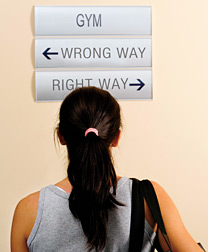Common Exercise Mistakes
And How to Correct Them Before You Injure Yourself
By Chelsea Cooper, MPA, CPT
Did you know that more than 60 percent of people who begin working out for the first time, or pick it up again after taking some time off, hurt themselves in the first month? That's significant for several reasons, not the least of which is if you are hurt, how are you going to keep working out and reach your fitness goals? The most important goal when undertaking any exercise program is not to
build muscle, burn fat, increase cardiovascular capacity, or anything else. Those are important, but the number-one priority is to keep from being injured. That's the only way you'll have a real chance of reaching your fitness goals.
The right way versus the wrong way to exercise; now this is a topic that needs to be discussed more often. Just the other day, a friend of mine told me she had injured her chest muscle while doing Pilates. Of course, her training was unsupervised; in her case, she was following along with a DVD. She went to the hospital and was diagnosed with a torn chest muscle. Who would think someone could seriously injure themselves by doing Pilates on a DVD? It happens more frequently than you think. And if you can hurt yourself doing Pilates, you can definitely hurt yourself while working out at the gym lifting weights or using any of the equipment.
It's a Question of Form
 All of my clients know I am a stickler for form. I don't care how much weight you are lifting or how many times you can perform an exercise; if your form is not correct, you need to reduce the amount of weight you are using and/or slow down. I'm a stickler on form for two important reasons:
All of my clients know I am a stickler for form. I don't care how much weight you are lifting or how many times you can perform an exercise; if your form is not correct, you need to reduce the amount of weight you are using and/or slow down. I'm a stickler on form for two important reasons:
#1 Safety (Injury Prevention). Correct form is key when doing any exercise. In fact, it's the first thing you must master! If not, you will eventually injure yourself. If you aren't sure if you are doing something correctly, please get a competent professional to assist you.
#2 Effectiveness. If you want to get the most out of your workouts, you have to use correct form. There is a right way to exercise and a wrong way to exercise, and this applies to each and every exercise you perform. Exercising is an art form that takes years to master. But let's face it; the average person does not see it that way, and that is why so many injuries occur and/or motivation disappears.
Most people have no clue how to do a proper squat, push-up, lunge, leg press, chest press - you get the idea. Lack of proper form is the number-one cause of injuries. Most people in the gym look around for someone who has a body they want and then try to mimic the same exercises the person is doing. Sometimes the person they are looking to as an example does have the correct form, but that doesn't mean you can mimic it correctly. It may have taken them years to learn how to do it the right way. But most of the time, the person they are looking too as a model saw someone else do the exercise and they are doing it wrong as well. It's a vicious cycle.
Repetitions/Sets
The general rule for repetitions and sets is straightforward: If you are trying to gain muscle or get stronger, you want to do low reps and higher sets. For example, you may be doing a leg press and you are trying to get stronger (hypertrophy), so you put on a heavier weight and do 6-8 reps per set for 4-5 sets. On the other hand, if you are just trying to build endurance and lean out, then you should do higher reps and lower sets; typically 15-20 reps per set for 2-3 sets. Now there are some middle reps and sets as well, like 10-12 reps/5-6 sets, but these are the basic rep/sets. The point is, it's important to understand how different sets, reps and even the types of exercises you perform affect your body. Again, talking to an exercise specialist will help you determine the best way to achieve your fitness goals.
Right Way, Wrong Way: 9 Exercise Mistakes
- Lat pulldown. The wrong way: pulling bar behind neck can cause serious injury to the shoulder. The right way: Pulling bar down in front of you while squeezing your back muscles (the rhomboids and latisimus dorsi).

